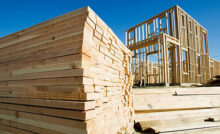TJI Floor Joist Time Saver
How To Quickly Cut TJI Joists


Typically when we order the joists they are shipped to the job site bundled together and cut 6″ or so longer than the length we ordered. At our local lumber yard they typically cut the joists to rough length using a chain saw. This leaves an uneven cut that must be trimmed to the final length.
Cut Each Joist One At A Time
The slowest way of cutting these joists is breaking apart the shipping package and pulling out each joist one by one, measuring them and then cutting them. As you can image moving around 30 ft long pieces of lumber, measuring each one and cutting each one can be quite time consuming. So one day when I was doing a site visit I had an idea about saving some time on this task.
Cut An Entire Bundle At Once
For simple houses that have all the joists one length we will try and cut the top flange of each joist at one time. This approach only works if you can get the factory ends all to one side and you can get them all lined up.
So we measure the length of the joists, mark them and snap a chalk line. Next we use a circular saw to make a cut through the top flange of all the joists (in a perfect world we’d have a very large saw to cut through the entire depth). The time saver here is when you make the cut you’re marking them all to length. This way you’re not walking 30 ft down each joist to hook on the tape and measure each one.
Let Them Run Wild
Another approach that is used quite frequently is to set all your joists tight to the rim joist at one end of the house and let the other end “run wild”. In other words let the extra length of the joists hang out over the plate on the far end. After all the joists are installed you can measure a few of them and then snap a chalk line. Then you can go through and cut each one off. This can be challenging especially for deeper joists like 14″!
Order Pre-Cut TJI Joists
Lastly and probably the easiest approach is ordering all your joists to length. This has become extremely popular in the last couple of years. In fact, I think it’s cheaper to order them pre-cut than it is to pay a carpenter on-site to cut them. They can cut each length, label them and ship them to the site reader to install.
Recent Posts
Framing Stick Nailer vs Coil Nailer
Which is Better a Stick Nailer or Coil Nailer? Framers have many choices in nailers…
How Many Roofing Nails Per Square of Shingles
Estimating How Many Nails for a New Roof When it comes to estimating materials for…
Composite / PVC Decking – Layout Tips & Advice
Composite / PVC Decking Layout Tips and Advice Composite and PVC decking have really changed…
Benefits of an ERV System (Energy Recovery Ventilator)
Benefits of ERV Systems (Energy Recovery Ventilator) If you're building a new home or doing…
Vermiculite Attic Insulation Abatement
Vermiculite Attic Insulation If your home was built before 1990 there is a chance it…
Nuisance Tripping of AFCI (Arc Fault) Circuit Breakers
Arc Fault (AFCI) Circuit Breakers Tripping Often An arc-fault circuit interrupter (AFCI) or arc-fault detection…

View Comments
Another method i found to work faster. Set the square end of the joist. leave the cut ends run wild past the mudsill. Chaulk your line across the top of the wild end. Use a large speed square to make a straight cut and lift each joist as needed to complete the cut through the joist. This will give you a more accurate lenght. The square end of joist bundled are not always even and will result in random in-accurate lenghts. Just to let you know, we framed over 250 homes in 5 years.